Many people avoid home bread baking because they don't think they have the right tools in their kitchen. But it's really easy to pull together a basic home bread baker's toolkit. You likely have everything you need already.
With any of my passions, I can be a bit of a tool freak. I spend hours browsing store shelves and websites looking for the best of the best. Reading the back of food magazines and checking out the best blogs to make sure I know what the good stuff is. Evenings dreaming about getting that special pan or the world's most accurate scale.
But you know what? All that time spend dreaming about tools is time better spent baking!
You can bake an awesome loaf of bread with tools you probably already have in your kitchen. So get hunting around your cupboards and pull together your own Bread Baker's Basic Toolkit.
The following list is all you need to make our "Learning Loaf", which is a basic pan bread that you can easily pull off 3-4 times per week.
One note: You will notice quite quickly that I haven't listed an expensive Stand Mixer in the list. Honestly, it's not necessary for making 1-2 loaves at home. And if you start getting into baking "artisan" bread with sourdough cultures, you won't be doing much mixing at all. So if you have a mixer, you can use it, but don't let the absence of a mixer delay your bread journey!
The Basic Home Bread Baker's Toolkit #
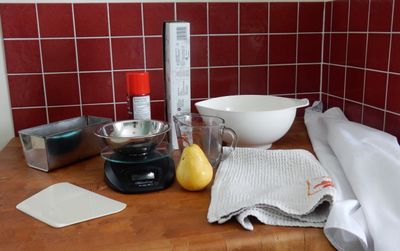
Here's a summary of the Basic Bread Baker's Toolkit:
- Mixing bowl
- Digital scale
- Scaling (measuring) bowl
- Water jug
- Pan spray
- Plastic wrap
- Kitchen towel
- Loaf pan(s)
Mixing Bowl #
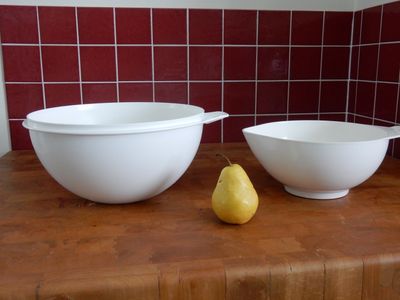
The smaller bowl will work fine, but if you have one larger, go for it!
A big mixing bowl will help you incorporate all your ingredients without spilling flour all over. Later, it will hold the dough as it rises during the 'bulk fermentation' stage. So the first item is a multi-tasker. Yay!
Your mixing bowl doesn't have to be anything fancy, so long as it's big enough. 3 litre - 4 litre capacity will do. I find a sturdy plastic bowl works just fine, but if you have a nice bit of Martha Stewart crockery, go for it.
I have a Tupperware 8 Litre bowl, so I use that. Other times I use a 3 litre melamine bowl Cindy and I got when we were married. But I've also used a Dollar Store Halloween candy bowl and it worked just as well.
Digital Scale #
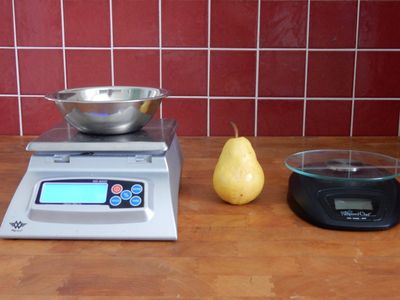
If I had my way, a food scale would be as common in home kitchens as a frying pan. There are cheap scales available all over and will help your baking immensely.
If I took 10 people who claim to be unable to bake bread and had them measure ingredients with cups and spoons, I would get 10 different piles of ingredients. People just plain scoop flour differently! It's so hard to get a consistent loaf of bread when you start with wildly different amounts of flour, water, salt and yeast.
So go buy a home food scale and it will pay itself back for again and again.
Here's what to look for in a scale:
- Capacity: What's the maximum weight it can handle? 5kg is plenty for at home; Accuracy: What's the smallest unit it can weigh? 1g increments will work fine. 0.5g is even better but not as common; Cleaning: Does it look easy to clean? Smooth lines makes it easier to wipe down the top; Batteries: If it uses AA or AAA batteries you've really hit the jackpot, since you can use rechargable batteries in it. On the other hand, those silver watch batteries last for ever.
At home I have a small Pampered Chef scale that was a gift. 5kg x 1g increments. Similar scales are $30 or so at the store. I also have a MyWeigh KD-8000 (8kg x 1g) scale that we used at the bakery. Overkill, perhaps, but I love it.
OK, back to the easier bits.
Scaling Bowl & Water Jug #
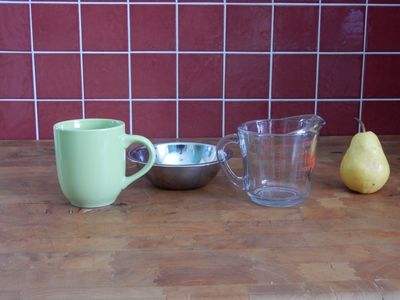
I'm a bit of a klutz when it comes to measuring salt and yeast. So for safety I measure small ingredients into a separate bowl before adding it to my flour.
Again, whatever you have handy. A coffee cup will work well too in a pinch.
As for a water jug, if you have a container that will hold up to a litre of water you're set. I tend to use a 500ml pyrex container and fill it twice, which works fine but I wish I had something one size bigger.
Pan Spray, Plastic Wrap and a Kitchen Towel #
All you need here is a way to oil your bowl when your dough ferments, and grease your loaf pans. Spray, oil, butter all work fine but I sure like the convenience of a can of spray oil.
Plastic wrap will help keep your dough from forming a skin while it rises. Whatever you have at home is fine and you can get by without it too.
A tea towel over your dough will help keep your dough slightly warmer, which is usually a good thing. And it looks nice and traditional too.
Loaf Pan(s) #
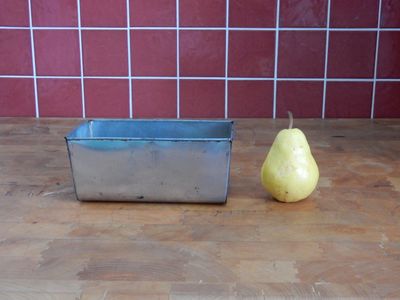
My mom's old loaf pan
There's no harm in making pan bread, especially when you're first starting out. It's easier to judge the final rise and it's easier to transfer the bread to and from the oven. Plus if you have a daughter who wants 'normal bread' for toast in the morning (as I do), your bread will get eaten faster too. Which gives you another reason to bake more. Win-win!
I have some old pans that used to belong to my mom. If you're out shopping, look for pans that are 9 x 5 1/2 x 3 inches (23 x 13 x 7 cm). If you have pans at home that are a slightly different size, use them!
Dough Scraper #
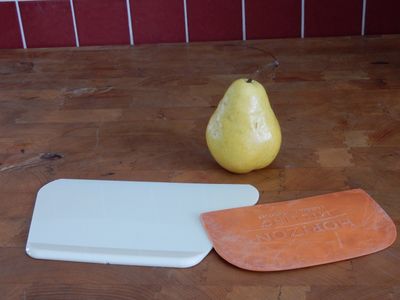
Two useful dough scrapers
This is the second thing you may not have on hand, but is well worth purchasing. A plastic dough scraper will help you get dough out of your mixing bowl and keep your counter clean when kneading. They are cheap and immensely useful.
They come in many shapes and sizes, so get what feels good in your hand. I use two: A curved scraper for use with my mixing bowl and a flat scraper for counters. I could just turn my curved scraper around to use the flat edge, but what can I say? I'm a tool geek.
That's it! Everything you need to bake that amazing loaf in your home oven. But there are four more items that may come in handy. If you have them, great, but they certainly aren't necessary.
- Apron: It's always good to work clean, in case someone comes to the door or you get an unexpected call that the Queen's popping over for tea. So an apron is a good idea.
- Mixing Spoon: It doesn't hurt to have a spoon handy for when you are first incorporating ingredients. I tend to use my hands because I hate doing dishes.
- Probe Thermometer: This is a good investment, but not necessary when you're just starting. Bread rises more consistently if the dough is held within a certain temperature range (73F-76F for yeasted doughs 77F - 80F for sourdough). The yeast likes a warm environment. A probe thermometer will let you know the temperature of your dough, so you can adjust where you let the dough sit to rise.
- Timer: A simple "countdown" timer will encourage you to keep kneading at the start. It will also remind you that you have bread rising on the counter while you're off enjoying your day and the yeast is doing all the work for you!
Oh yeah! I almost forgot!
What's the deal with the pear? #
That's a Reference Pear. So you know how big everything is. :) Hat tip to Paul and Quinns for that idea.